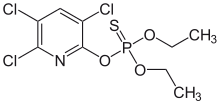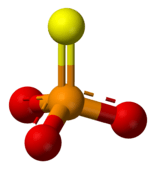Thiophosphate
Thiophosphates (or phosphorothioates, PS) are chemical compounds and anions with the general chemical formula PS
4−xO3−
x (x = 0, 1, 2, or 3) and related derivatives where organic groups are attached to one or more O or S. Thiophosphates feature tetrahedral phosphorus(V) centers.[1]
- For the thiophosphate esters see organothiophosphates.
Organic
Organothiophosphates are a subclass of organophosphorus compounds that are structurally related to the inorganic thiophosphates. Common members have formulas of the type (RO)3−xRxPS and related compounds where RO is replaced by RS. Many of these compounds are used as insecticides, some have medical applications, and some have been used as oil additives.[1]
2.png) zinc dialkyldithiophosphate, an oil additive.[2]
zinc dialkyldithiophosphate, an oil additive.[2] Phosphorothioates are the basis for antisense therapies.
Phosphorothioates are the basis for antisense therapies. Amifostine, which is used in cancer chemotherapy.
Amifostine, which is used in cancer chemotherapy. Chlorpyrifos, a popular insecticide.
Chlorpyrifos, a popular insecticide. Malathion, a popular insecticide.
Malathion, a popular insecticide.
Oligonucleotide phosphorothioates (OPS) are modified oligonucleotides where one of the oxygen atoms in the phosphate moiety is replaced by sulfur. They are the basis of antisense therapy, e.g., the drugs fomivirsen (Vitravene), oblimersen, alicaforsen, and mipomersen (Kynamro).[3]
Inorganic

The simplest thiophosphates have the formula [PS4−xOx]3−. These trianions are only observed at very high pH, instead they exist in protonated form with the formula [HnPS4−xOx](3−n)− (x = 0, 1, 2, or 3 and (n = 1, 2, or 3).
Monothiophosphate

Monothiophosphate is the anion [PO3S]3−, which has C3v symmetry. A common salt is sodium monothiophosphate (Na3PO3S). Monothiophosphate is used in research as an analogue of phosphate in biochemistry. Monothiophosphate esters are biochemical reagents used in the study of transcription,[4] substitution interference assays. Sometimes, "monothiophosphate" refers to esters such as (CH3O)2POS−.[5]
Dithiophosphates
Dithiophosphate has the formula [PO2S2]3−, which has C2v symmetry. Sodium dithiophosphate, which is colorless, is the major product from the reaction of phosphorus pentasulfide with NaOH:[6]
- P2S5 + 6 NaOH → 2 Na3PO2S2 + H2S + 2 H2O
Dithiophosphoric acid is obtained by treatment of barium dithiophosphate with sulfuric acid:
- Ba3(PO2S2)2 + 3 H2SO4 → 3 BaSO4 + 2 H3PO2S2
Both Na3PO2S2 and especially H3PO2S2 are prone toward hydrolysis to their monothio derivatives.
Tri- and tetrathiophosphates
Trithiophosphate is the anion [POS3]3−, which has C3v symmetry. Tetrathiophosphate is the anion [PS4]3−, which has Td symmetry.
PxSy: binary thiophosphates and polyphosphates

A number of these anions known. Some have attracted interest as components in fast ion conductors for use in solid state batteries. The binary thiophosphates do not exhibit the extensive diversity of the analogous P-O anions but contain similar structural features, for example P is 4 coordinate, P−S−P links form and there are P−P bonds. One difference is that ions may include polysulfide fragments of 2 or more S atoms whereas in the P−O anions there is only the reactive −O−O−, peroxo, unit.
- PS−
3 is the analogue of the nitrate ion, NO−
3 (there is no PO−
3 analogue); it was isolated as the yellow tetraphenylarsonium salt[8] - PS3−
4 is the sulfur analogue of PO3−
4, and like PO3−
4 is tetrahedral. - P
2S4−
7 the pyrothiophosphate ion consisting of two corner sharing PS4 tetrahedra, analogous to the pyrophosphates.[9] - P
2S4−
10 An ion which can be visualised either as two PS4 tetrahedra joined by a disulfide link or a pyrothiophosphate where the bridging −S− is replaced by −S4−.[10] - P
2S2−
6 edge-shared bitetrahedral structure. The structure is therefore similar to the isoelectronic Al2Cl6 dimer. The oxygen analogue, dimetaphosphate P
2O2−
6, in contrast, is not known, the metaphosphates favour polymeric structures of chains or rings.[9] - P
2S2−
8 and P
2S2−
10 are related to P
2S2−
6 but their two bridging −S− atoms are replaced by −S−S− in P
2S2−
8 and by an −S−S−S− bridge in P
2S2−
10.[11] - P2S4−
6 These form water-stable salts.[12] The anion has an ethane-like structure and contains a P−P bond. The formal oxidation state of phosphorus is +4. The oxygen analogue is the hypodiphosphate anion, P
2O4−
6. - P
3S3−
9 contains a six-membered P3S3 ring. The ammonium salt is produced by reaction of P4S10 in liquid ammonia.[13] Another way of visualising the structure is that it is the P4S10 adamantane (P4O10) structure with a PS3+ vertex removed. - P
4S4−
8 contains a square P4 ring,[8] P
5S5−
10 contains a P5 ring and P
6S6−
12 a P6 ring.[11] These (PS−
2)
n cyclic anions contain P with an oxidation state +3. Note they are not trigonal as arsenic(III) is in arsenites, but are tetrahedral with two bonds to other phosphorus atoms and two to sulfur. The P
6S6−
12 anion is analogous to the P
6O6−
12 ring anion.[14] - P
4S2−
2 An unusual butterfly-shaped ion, SP(P2)PS, which can be visualised as a P4 molecule where two P−S bonds replace one P−P bond.[15] - P
7S3−
3 is a sulfido heptaphosphane cluster anion.[8]
References
- J. Svara, N. Weferling, T. Hofmann "Phosphorus Compounds, Organic" in Ullmann's Encyclopedia of Industrial Chemistry, Wiley-VCH, Weinheim, 2006. doi:10.1002/14356007.a19_545.pub2
- H. Spikes "The history and mechanisms of ZDDP" Tribology Letters, Vol. 17, No. 3, October 2004. doi:10.1023/B:TRIL.0000044495.26882.b5.
- Kurreck, J., "Antisense technologies. Improvement through novel chemical modifications", European Journal of Biochemistry 2003, 270, 1628-1644.doi:10.1046/j.1432-1033.2003.03555.x
- Lorsch JR; Bartel DP; Szostak JW (1995). "Reverse transcriptase reads through a 2′–5′ linkage and a 2′-thiphosphate in a template". Nucleic Acids Res. 23 (15): 2811–2814. doi:10.1093/nar/23.15.2811. PMC 307115. PMID 7544885.
- Poat JC, et al. (1990). "A thiophosphate bridged platinum–zinc hetero-bimetallic complex: [(Me2PhP)2Pt{OSP(OR)2}2ZnCl2". J. Chem. Soc., Chem. Commun.: 1036–1038.
- R. Klement "Phosphorus" in Handbook of Preparative Inorganic Chemistry, 2nd Ed. Edited by G. Brauer, Academic Press, 1963, NY. Vol. 1., p. 571.
- Dimitrov, A.; Hartwich, I.; Ziemer, B.; Heidemann, D.;; Meisel, M. (2005). "Synthese, Charakterisierung und Struktur des donorstabilisierten monomeren [PS3]− – Anions (Monometatrithiophosphates)". Zeitschrift für anorganische und allgemeine Chemie. 631: 2439–2444. doi:10.1002/zaac.200500246.CS1 maint: extra punctuation (link)
- Greenwood, Norman N.; Earnshaw, Alan (1984). Chemistry of the Elements. Oxford: Pergamon Press. pp. 509–510. ISBN 978-0-08-022057-4.
- Phosphorus: Chemistry, Biochemistry and Technology, Sixth Edition, 2013, D.E.C. Corbridge, CRC Pres, Taylor Francis Group, ISBN 978-1-4398-4088-7
- Aitken, Jennifer A.; Canlas, Christian; Weliky, David P.; Kanatzidis, Mercouri G. (2001). "[P2S10]4−: A Novel Polythiophosphate Anion Containing a Tetrasulfide Fragment". Inorganic Chemistry. 40 (25): 6496–6498. doi:10.1021/ic010664p. ISSN 0020-1669.
- Holleman, Arnold Frederik; Wiberg, Egon (2001), Wiberg, Nils (ed.), Inorganic Chemistry, translated by Eagleson, Mary; Brewer, William, San Diego/Berlin: Academic Press/De Gruyter, pp. 734–735, ISBN 0-12-352651-5
- Gjikaj, Mimoza; Ehrhardt, Claus (2007). "New Hexachalcogeno–Hypodiphosphates of the Alkali Metals: Synthesis, Crystal Structure and Vibrational Spectra of the Hexathiodiphosphate(IV) Hydrates K4[P2S6]·4 H2O, Rb4[P2S6]·6 H2O, and Cs4[P2S6]·6 H2O". Zeitschrift für anorganische und allgemeine Chemie. 633 (7): 1048–1054. doi:10.1002/zaac.200600339. ISSN 0044-2313.
- Wolf, G.-U.; Meisel, M. (1982). "Beiträge zur Chemie von Phosphorverbindungen mit Adamantanstruktur. VII[1]. Über Darstellung und Eigenschaften von Nonathio-cyclotriphosphat". Zeitschrift für anorganische und allgemeine Chemie. 494 (1): 49–54. doi:10.1002/zaac.19824940106. ISSN 0044-2313.
- Ebert, M.; Nassler, J. (1989). "The Ring Acid, H6P6O12 and Ring Acid, H4P4O10 and Their Salts". Phosphorus, Sulfur, and Silicon and the Related Elements. 41 (3–4): 462. doi:10.1080/10426508908039741. ISSN 1042-6507.
- Rotter, Christiane; Schuster, Michael; Karaghiosoff, Konstantin (2009). "An Unusual Binary Phosphorus−Tellurium Anion and Its Seleno- and Thio- Analogues: P
4Ch2−
2 (Ch = S, Se, Te)". Inorganic Chemistry. 48 (16): 7531–7533. doi:10.1021/ic901149m. ISSN 0020-1669.